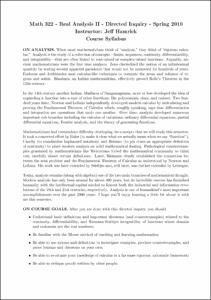Please use this identifier to cite or link to this item:
http://hdl.handle.net/10267/15753Full metadata record
| DC Field | Value | Language |
|---|---|---|
| dc.contributor.author | Hamrick, Jeff | - |
| dc.date.accessioned | 2013-03-05T16:24:15Z | - |
| dc.date.available | 2013-03-05T16:24:15Z | - |
| dc.date.issued | 2010-01-13 | - |
| dc.identifier.uri | http://hdl.handle.net/10267/15753 | - |
| dc.description | This syllabus was submitted to the Office of Academic Affairs by the course instructor. Uploaded by Archives RSA Josephine Hill. | en_US |
| dc.description.abstract | When most mathematicians think of “analysis,” they think of “rigorous calculus.” Analysis is the study of a collection of concepts—limits, sequences, continuity, differentiability, and integrability—that are often linked to real-valued or complex-valued functions. Arguably, ancient mathematicians were the first true analysts. Zeno discredited the notion of an infinitesimal quantity by stating several apparent paradoxes that would not be unraveled for hundreds of years. Eudoxus and Archimedes used calculus-like techniques to compute the areas and volumes of regions and solids. Bhaskara, an Indian mathematician, effectively proved Rolle’s Theorem in the 12th century. In the 14th century another Indian, Madhava of Sangamagrama, more or less developed the idea of expanding a function into a sum of other functions, like polynomials, sines, and cosines. Two hundred years later, Newton and Leibniz independently developed modern calculus by articulating and proving the Fundamental Theorem of Calculus which, roughly speaking, says that differentiation and integration are operations that undo one another. Over time, analysis developed numerous important sub-branches including the calculus of variations, ordinary differential equations, partial differential equations, Fourier analysis, and the theory of generating functions. Mathematicians had tremendous difficulty developing the concepts that we will study this semester. It took a concerted effort by Euler (to make it clear what we actually mean when we say “function”), Cauchy (to standardize haphazard notation), and Bolzano (to pin down an appropriate definition of continuity) to place modern analysis on solid mathematical footing. Pathological counterexamples generated by mathematicians like Weierstrass forced the mathematical community to think very carefully about certain definitions. Later, Riemann clearly established the connection between the area problem and the Fundamental Theorem of Calculus as understood by Newton and Leibniz. His work was later extended by Stieltjes and, still later, was further extended by Lebesgue. Today, analysis remains (along with algebra) one of the two main branches of mathematical thought. Modern analysis has only been around for about 400 years, but its incredible success has furnished humanity with the intellectual capital needed to foment both the industrial and information revolutions of the 18th and 21st centuries, respectively. Analysis is one of humankind’s most important accomplishments over the past 2000 years. I hope you’ll enjoy learning a little bit about it with me this semester. | en_US |
| dc.language.iso | en_US | en_US |
| dc.publisher | Memphis, Tenn. : Rhodes College | en_US |
| dc.relation.ispartofseries | Syllabi CRN;20771 | - |
| dc.rights | Rhodes College owns the rights to the archival digital objects in this collection. Objects are made available for educational use only and may not be used for any non-educational or commercial purpose. Approved educational uses include private research and scholarship, teaching, and student projects. For additional information please contact archives@rhodes.edu. Fees may apply. | - |
| dc.subject | Syllabus | en_US |
| dc.subject | Curriculum | en_US |
| dc.subject | Academic departments | en_US |
| dc.subject | Text | en_US |
| dc.subject | Mathematics and Computer Science, Department of | en_US |
| dc.subject | 2010 Spring | en_US |
| dc.title | MATH 322-01, Real Analysis II, Spring 2010 | en_US |
| dc.type | Syllabus | en_US |
| Appears in Collections: | Course Syllabi | |
Files in This Item:
| File | Description | Size | Format | |
|---|---|---|---|---|
| 2010_SPRING_MATH_DI-01_20771.pdf | 37.56 kB | Adobe PDF |  View/Open |
Items in DSpace are protected by copyright, with all rights reserved, unless otherwise indicated.